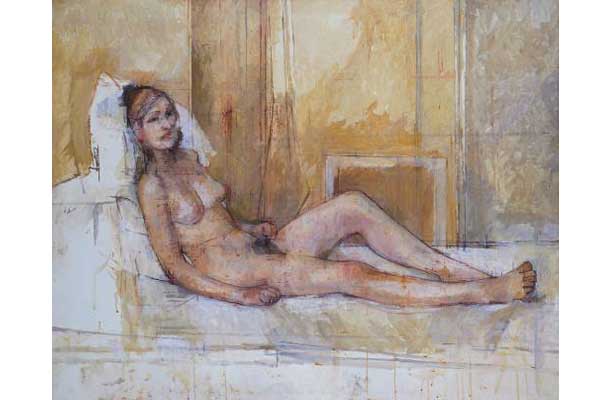
William Coldstream, Reclining Nude 1974-6
This is the second post in a series of posts where Neil Plotkin, who has been living in London for the summer, looks at a some significant painters coming out of the The Slade School of Art in the UK. This article introduces William Coldstream and points to where to look for more information on this significant British perceptual painter.
The Slade School of Art – Part Two, William Coldstream by Neil Plotkin
Though not well known in the United States, William Coldstream could be argued to be one of the most influential artists in the UK since the end of the Second World War. Born in 1908, Coldstream studied at the Slade School of Art. During the 1930’s with a few other artists, he started the Euston Road School. Based on naturalism and realism, the school was a reaction to the prevailing avant-garde of the time. After the war, and building on his methods from the Euston Road School, he taught at the Camberwell School of Art where he had instructed his two best-known students – Patrick George and Euan Uglow. In 1949, he moved to the Slade School of Art as the director bringing with him George as a teacher and Uglow as a student. During his time there he made the Slade an internationally highly regarded institution. Despite this strong legacy, it was when he became Chairman of the National Advisory Council on Art Education that he is considered to have reshaped British art education by issuing what are know as the first and second Coldstream Reports. These reports defined what was necessary for a degree in fine art and design in the UK “to lend academic credibility” to studio practice.
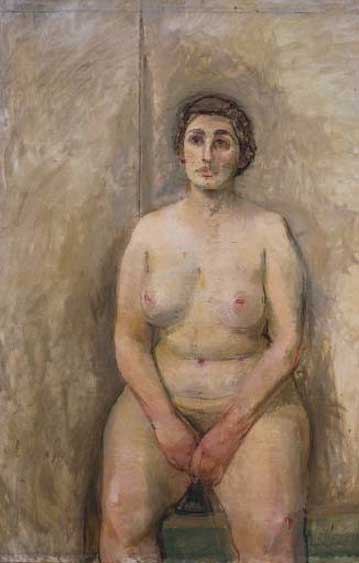
William Coldstream – Seated Nude 1952-3
As for his studio practice, Coldstream would only work from direct observation and measuring was a fundamental part of his working method (and teaching method). As he worked, he would hold his arm straight out and measure with his thumb to his brush and compare it to other elements within the painting-this allowed him to paint without relying exclusively on conventional perspective. To do this sort of measuring, he would put marks within his painting to anchor each part of the painting. It is this marking system that is seen in so many artists that have been influenced by him.
What I find exciting and interesting is if you look at his work and the early work of Uglow and Patrick George, the paintings of the former students are quite similar to their mentor. But as the two matured, their work diverges yet there is still a distinct link to Coldstream – With Uglow, he takes the measuring to an extreme and with George, there is an open and loose brushwork and the open space comes to play a large role (the next two and final postings in the Slade School of Art will be about those two artists).

Orange Tree I 1974-5
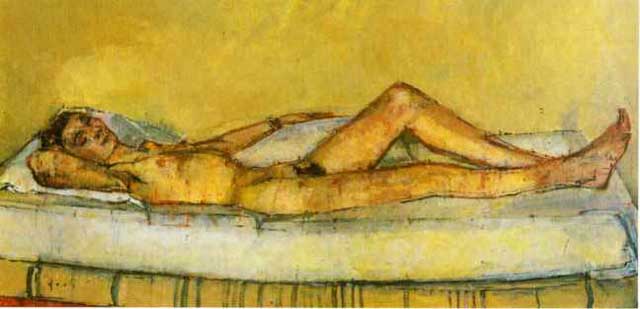
Reclining Nude
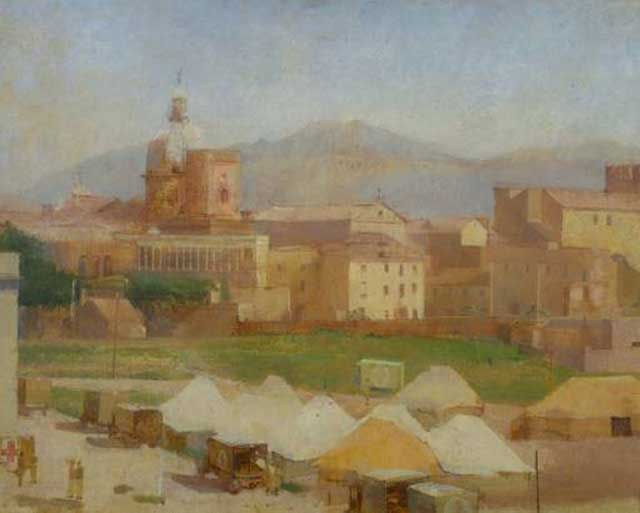
Casualty Reception Station, Capua 1944
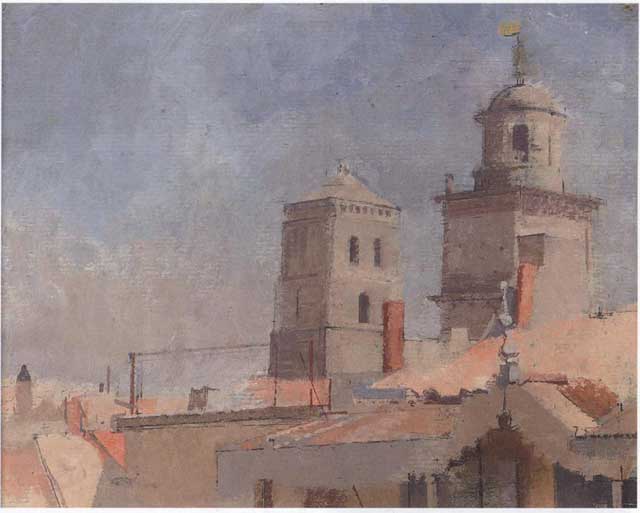
Hotel de Ville a St Trophime, Arles
(click for larger view)
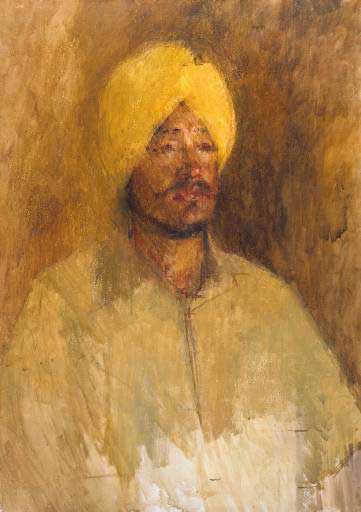
Havildar Ajmer Singh 1943
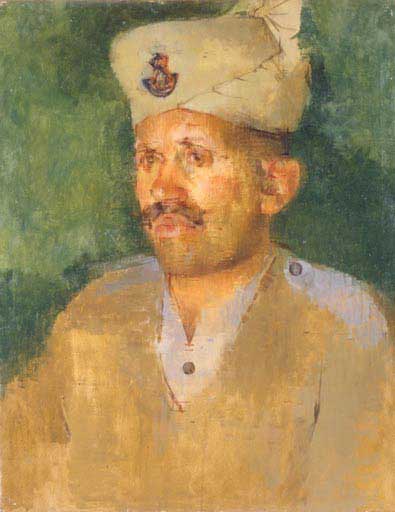
Rifleman
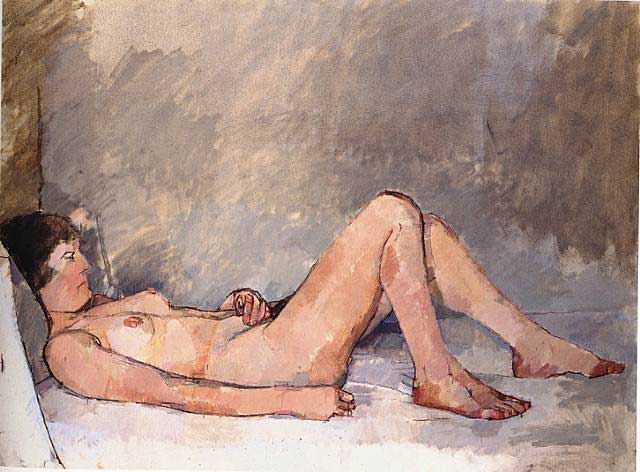
Euan Uglow
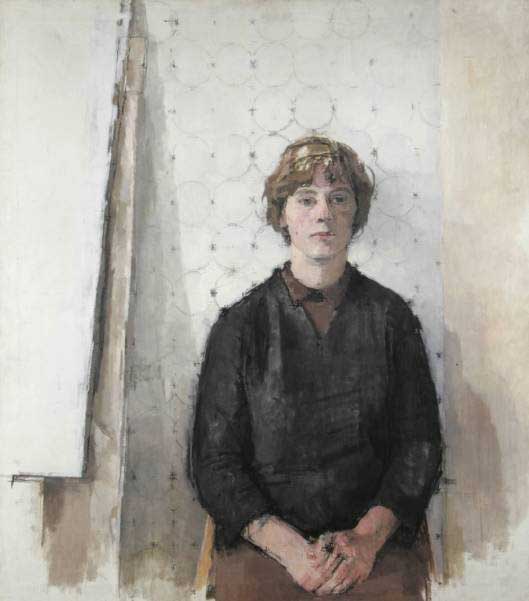
Patrick George
Links on William Coldstream
Wikipedia article
The Tate Gallery
The British Council
Bristol Life Drawing Blog for an account of the Coldstream methods:
Books to consider (buying them from the link below helps support this site)
From Amazon – The Artist at Work: On the Working Methods of William Coldstream and Michael Andrews

The Artist at Work: On the Working Methods of William Coldstream and Michael Andrews [Paperback]
(from the publisher)
With this study, Colin St John Wilson focuses on the working methods of William Coldstream and Michael Andrews, two leading members of the School of London. This is the first full-scale study to focus on the working methods of artists by direct observation – in this case two leading members of the School of London, William Coldstream and Michael Andrews. This comparative analysis contains hitherto unpublished material by the artists and includes the author’s copious notes and his own sketches and photographs of the artists at work painting portraits of him. William Coldstream (1908–1987) was one of the most influential forces in British art in the twentieth century, both in his painting and in his teaching, firstly at the Euston Road School and subsequently in his Headship at Camberwell and the Slade School of Art. Michael Andrews (1928–1995) was his outstanding pupil and quickly established a major reputation in his own right. His work largely took the form of a theme with variations, and the Thames series, sadly unfinished, promised to be his crowning work. Colin St John Wilson bases his study on personal friendship and the experience of an extraordinary number of sittings, 96 with Coldstream and 80 with Andrews, which were the settings for extended discussion with both artists. This fascinating study highlights the very different working methods of the two artists, and yet shows their concern to represent through paint alone the reality of human presence.
From Amazon – The Artist at Work: On the Working Methods of William Coldstream and Michael Andrews





This is a great posting. I have been an admirer of Coldstream and Uglow, among others from this group, for some time. I eagerly await the upcoming Slade postings.
Thanks to both Neil and Larry for highlighting Coldstream and the Slade School, a great series of posts. When I was looking now at Coldstream, Garcia came to mind in many ways, and I wonder if it is because I like the accuracy without being “anal,” the artist’s preference to observe carefully and sensitively, with patience that never seems to end. Yet, it is not just observed marks, the artist behind it is so evident without trying. Less “bravura” and more modesty in the face of beauty and sincere perception of light, form, line, color.
Yeah I agree; nice series of posts about the Slade and Coldstream. Like Rebecca, I also thought of Lopez Garcia, but Coldstream’s work also made me think of Giacometti, especially Giacometti’s early work just after he had abandoned Surrealism. I’m not sure if they knew each other, or were familiar with each other’s working methods, but the time frame is right. I think I read that Uglow had met him (Giacometti) on a few occasions…Maybe the similarities can be attributed to the fact they both were hugely influenced by Cezanne.
Rebecca – I really think that you’ve hit it on the head by describing these artists as patient. Perhaps by knowing that your painting will probably take several years to create, you don’t rush into bad solutions in order to finish something else in the painting. I too feel like there is some sort dialog between their work – i didn’t write anything about that because I have never come across anything about Lopez-Garcia looking anywhere but to Spanish traditions. I hadn’t thought of Francis’s point of Giacometti and it’s great. There was a great deal of dialog in the 50’s between him and a lot of English painters – he was often considered an honorary School of London painter. Uglow did go with David Sylvester to meet him in Paris around 1957 so there are direct connections between a lot of these artists. I’m working on the other installments and luckily we have a really meaty post from Larry to work on until I finish those.
This is fascinating stuff and I am delighted to have stumbled on this site. I leart to draw in London in the ’70s when the Life rooms divided between on the one hand followers of David Bomberg and Frank Auerbach (lots charcoal and thick handmade paper) and on the other Coldstream / Uglow and the measuring method (sharp HB pencils). That is to say this debate polarised drawing tuition in those schools where perception mattered a damn and they dwindled as the decade progressed towards a dour form of conceptualism that saw no place for drawing of any sort.
Watching Lopez Garcia at work in the film ‘Un Sol de Membrillio’ (the Quince Tree Sun) shows that he was clearly using a very similar approach to Coldstream’s – plotting the compexity of his quince tree over several months with measurements , plumb line, and a network of little crosses. I’m sure Neil is right that this owes more to Spanish traditions than The Slade school, in fact the notion of a grid connecting points horizontally and verticaly on a picture plane must have been fundamental to perspective representation since Alberti.(Van Gogh used a perspective frame of gridded squares to help him fix objects in space – which I think was a reasonably common 19th C drawing aid
I am sure that I read something about a meeting between Coldstream and Giacometti in the late fifties in London it may have been in Bruce Laughton’s excellent book on the Euston Road School.
Chris,
I love the way you’ve described the two schools within the one school – funny and to the point. It is sad that the school has moved away from perceptual work. That seems to be the path of art education and i think it’s been the same in this country. Yale is a very different school than it was many years ago and that I feel was the American equivalent to the Slade.
I was very interested in your comment about Coldstream and Giacometti (a life long inspiration for me). I had never even considered that he and Coldstream would have had relationship despite the obvious visual connection which Francis pointed out. I did a little search and came up with this interesting link of an article by Bruce Laughton called “Coldstream and Giacometti in London” in the British Art Journal, IX, 3 (Spring 2009) pp.79-85 , 2009
http://www.thefreelibrary.com/Coldstream+and+Giacometti+in+London-a0219821776
It has a lot of information on London during a very interesting period.
During the 1970’s I was taught by William Coldstream, Patrick George and Euan Uglow at The Slade School. This proved to be a heady mix and it took several years to distil their influences. Most memorable was Coldstream in his last year as Director. He was a relaxed and approachable individual, uncomplicated and always fascinated and amused by how most students managed to make the process of painting complex and arduous. This might seem strange given that his work is sometimes perceived as arduous and overly concerned with the discipline of measurement. The fact is that he was deeply engaged by the pursuit of tying down the difference between seeing and looking. Go close to one of his paintings and you can enjoy the loose paintwork, the ambiguity in his drawing, splashes, dots and dribbles that cover the surface. None of these will be see in a Uglow.
Thankyou for this site; it is much needed; no progress without community.
You can see more works by Coldstream / Uglow / Patel here
Coldstream
http://www.bbc.co.uk/arts/yourpaintings/artists/william-menzies-coldstream
Uglow
http://www.bbc.co.uk/arts/yourpaintings/artists/euan-uglow
Patel
http://www.bbc.co.uk/arts/yourpaintings/artists/patel-suresh-b-1973